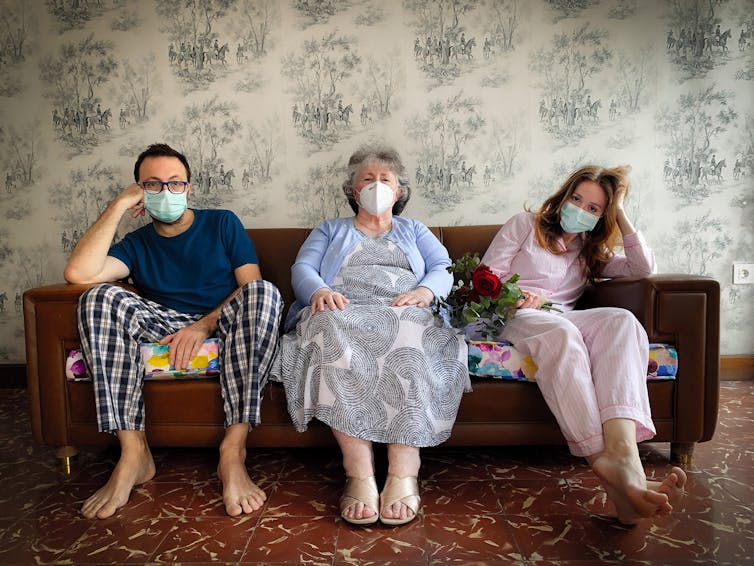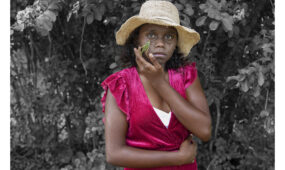New shows tell our isolation stories on screen
InReview
Social distancing forced most film and television production into shutdown. But a new batch of screen content shows the virtues of bricolage culture – tinkering with what’s available.

Coronavirus & Me is the kind of hybrid user-generated television production we can expect to see more of in coming months.
With the majority of Australia’s film and television industry shut down, and essential production shifting to bedrooms, YouTube-style content is elbowing in to the free-to-air and subscription-video-on-demand (SVOD) experience.
Tinkering with whatever is at hand to produce media content reflects the emergence of “bricolage” culture into the mainstream.
Picking and choosing
Curating experiences is all the rage, from takeaway fine dining with Spotify playlists to delivered cheese platters and handpicked reading. But curation suggests a purposeful selection from premium products. Bricolage, on the other hand, makes the most out what’s within reach.
The French verb bricoler and noun bricoleur roughly translate as DIY tinkering and a professional handyman respectively. In fine art circles, bricolage refers to art made out a diverse range of non-traditional materials. Unlike collage or montage, the combined elements are unexpected and wouldn’t normally sit together.
The artistry of bricolage is how individual elements maintain their cultural and material provenance but the final arrangement invites new meanings and connections from the viewer.
Stories from home
New streaming platform, iWonder, was quick to respond to COVID-19, calling in March for short user-generated documentaries about Australians’ experiences. The initial 14-minute Coronavirus & Me compilation featuring five short stories was picked up by 7plus and aired at the end of April.
The appeal of user-generated content (UGC) to broadcasters is in the heightened authenticity of unmediated video diaries, remote production and low costs. Amateur content on television isn’t new – see the 25-year legacy of Australia’s Funniest Home Videos – but it’s usually fronted by a charismatic host with theatrical music to smooth over imperfections.

Get InReview in your inbox – free each Saturday. Local arts and culture – covered.
Thanks for signing up to the InReview newsletter.
Coronavirus & Me offers heartfelt video diaries from diverse and enjoyable personalities. There’s a little touching up, such as stock music and imagery, but no host.
Sydney-based director producers Alex and Catherine Weinress, of Hixon Films, have arranged the submissions into a meaningful journey: fleeing home to Sydney from Wuhan; a mortuary worker’s fears; a performing artist’s coping strategies; an Instagram-inspired parody of Tom Hanks’ Castaway; and a refined short film called Oma that documents a family’s trials in isolation with a grandma with Alzheimer’s disease.
A mixed bag of professional and amateur stories, Coronavirus & Me would usually inhabit far corners of the online universe. As a compilation, it contributes to a common understanding of shared adversity and community.
Expect the unexpected
ABC’s At Home Alone Together, an eight-part parody series hosted by Ray Martin, is another example of bricolage production. Supported by Screen Australia, the series provides opportunities for emerging writers and performers during lockdown.
Again, the mixed offering might not normally reach production, but its appeal is in the incongruous situation we all share. It’s hard to know what to expect from one segment to the next – an unusual quality to see in broadcast genres.
Making the most of whatever’s at hand during lockdown is producing some gems. Maria Albiñana and Luke Eve from More Sauce have launched a 10-part web series aptly titled Cancelled, which follows the actor and producer couple cancelling their wedding in Spain as they face lockdown away from home. The docu-drama strikes an elegant balance between the rawness of a smart phone diary and the artful storytelling of professional production, and more than 26,000 viewers tuned in within a week of its Facebook launch.

Orange is the New Black creator Jenji Kohan is working on quarantine series Social Distance for Netflix. Writing and production will be done virtually and the cast will act and film themselves at home.
Stories in uncertain times
Understanding human experience is an important aspect of these emerging shows, streams and ways of watching. The process of reflecting and sorting experiences is inherent to the traditional written diary, addressing oneself in the future.
In Italy, director Olmo Parenti reversed this idea to capture the reported lag of other countries. He asked Italians in lockdown to record a message to their past self of 10 days prior.
America’s Public Broadcasting Service is providing an incredible bricolage of citizen experiences via text, video diaries, images, and gifs as American Portrait.
Meanwhile, the State Library of NSW has partnered with ABC Radio Sydney to collate written reflections in The Diary Files. The intention is to create a time capsule for future interpretation.
A decade ago, the promise of YouTube and other online media was to foster a more participatory culture. The pandemic and new examples of isolation content reveal the essential role of editors and producers as bricoleur – vital to piecing together our stories.
Aaron Burton is a lecturer in Media Arts at the University of Wollongong and a practice-based researcher in personal documentary film and photography. This article is republished from The Conversation under a Creative Commons licence. Read the original article.
![]()
Support local arts journalism
Your support will help us continue the important work of InReview in publishing free professional journalism that celebrates, interrogates and amplifies arts and culture in South Australia.
Donate Here




